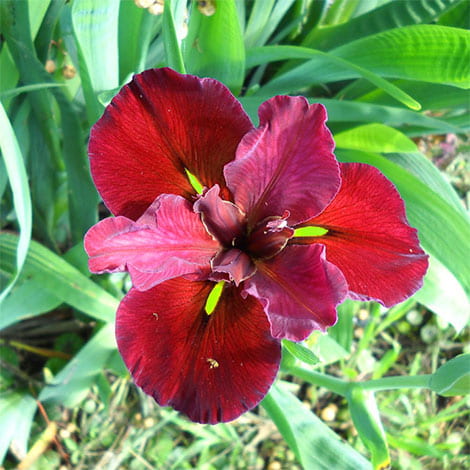Asked by: Patricia of Charlestown, WV
A: Water Lilies, Lotus, Blue Flag Iris, Hyacinth—so many aquatic plants, so little time. A pond full of these colorful beauties and hardworking, submerged oxygenators adds splendor and life to your waterscape. Not only that, but birds will visit, bugs will buzz through, and aquatic critters will stop by, attracted by the blooms and foliage.
Like your terrestrial garden, a water garden needs some planning and forethought; without it, you could end up with an untamed aquatic jungle. Here's what we recommend for adding plants to your pond.
Choose Wisely
Before you get your feet wet and your hands dirty, consider what plants you want in your water feature and how many you'll need.
Aquatic plants are typically categorized by their function in a pond. They include floating plants, like Water Hyacinth and Water Lettuce, that have roots that reach down from the water's surface; submerged plants, like Vallisneria and Hornwort, that live on the pond's bottom and release oxygen into the water; bog plants, like Cattails and Iris, that ring the perimeter of the pond; and Water Lilies and Lotus, which provide dramatic surface color and underwater shade.
When browsing for plants, select a mixture of floating, submerged, bog, and lilies/lotus, with the goal of covering about 60 percent of your water's surface. A sample plant shopping list for a 50-square-foot pond looks something like this:
- 6 to 12 floating plants
- Several submerged plants
- 2 bog plants
- 1 water lily
Don't forget to add aquatic plant media, aquatic planting soil, fertilizer, and containers (like pots, plant bags, planting baskets, and floating planters) to your list. You'll need them when you transplant and care for the new greenery. You can get all your pond gardening supplies in one go with our Planting Kit bundles in large and small sizes.
Planting How-To
Once you've planned out and purchased your plants, it's time to move them into your water garden. Individual types of aquatic plants need to be handled differently:
- Floating Plants: Place these easy-care plants in the water. They will float freely and take up nutrients through their root systems.
- Submerged Plants: Grow these underwater plants in plant bags or other planters. Fill your container with planting soil, plant several bunches of them together, top with aquatic media, soak pot, and then submerge into the desired section of your pond. Alternatively, tie a bunch to a weight, then drop it into the pond, using one bunch for every two square feet of surface area. Their roots will take up nutrients from the water. Submerged plants can also free-float in your water features.
- Bog Plants: Best grown in containers filled with aquatic plant soil and media, bog plants like their roots wet. Position them around the edges of your pond, not lower than six inches deep, or inside your pond with a floating island planter.
- Water Lilies and Lotuses: These beauties thrive in pots, like those found in our Planting Kits for Water Lilies & Lotus. To transplant, fill your tub with our premium aquatic planting soil and top with aquatic planting media. Position the tuber inside the soil with the growing tip pointed up. Soak pot then submerge so the plant's tip is three to six inches deep. Once the plant grows and its leaves reach the water's surface, place the pot in a deeper area of your pond.
- Artificial Aquatic Plants: Simply place these maintenance-free plants in the water. They will float freely, or they can be weighted down. While artificial plants do not provide all the benefits of real plants, they do provide shade and protection to aquatic life. Our realistic-looking faux plants also add visual interest and remain resistant to weather, pests, and hungry fish.
Feed for Growth
Your newly planted plants need nutrients for beautiful blooms, so don't forget the fertilizer tabs! CrystalClear Thrive feeds aquatic plants throughout their growing season, encouraging greenery and bloom production. Tablets should be added to the soil every two to four weeks for best results.
Use one to two tablets per gallon of potting soil and push them deep into the media three inches from the crown of the plant. Pack the hole with soil to prevent the fertilizer from being released into the water, and you're good until next month.
Learn More About Aquatic Plants
Do you have more pond gardening questions? Reach us at 866-POND-HELP (766-3435) or check out these articles below:
How to Pick Aquatic Plants
How to Plant Water Lilies
How to Divide Pond Plants
Last Updated: February 15, 2024

